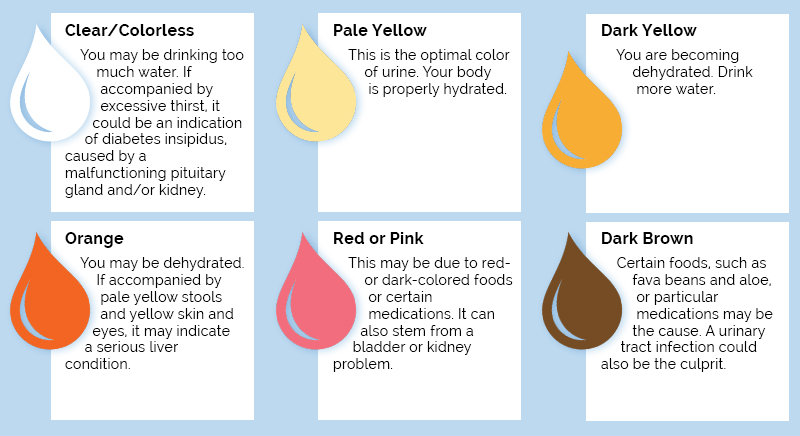Imagine waking up one morning and taking a glance at the toilet bowl. What you see isn’t the typical, straw-like yellow you’re used to, but a shocking shade of bright orange. It’s a moment that makes you wonder, “What’s happening to my body?” Your urine is a window into your overall health – its color and consistency can hint at various factors impacting your well-being, both subtle and serious.

Image: www.tpsearchtool.com
This guide will delve into the fascinating world of urine coloration, providing you with an in-depth understanding of what’s considered normal and what might signal an underlying health concern. You’ll learn about the pigments that give urine its color, discover the factors that can cause fluctuations in its hue, and gain insights into what your pee might be telling you about your body.
The Decoding of Urine Color: A Complex World of Pigments
Urine is typically a pale yellow shade, often described as “straw-colored.” This color arises from a pigment called urochrome, a by-product of the breakdown of heme, a component of hemoglobin in our red blood cells. When our bodies break down old red blood cells, they excrete the heme through urine, giving it its characteristic color.
The intensity of yellow in your urine can vary depending on your hydration levels. When you’re well-hydrated, your body produces more dilute urine, leading to a lighter, almost clear color. Conversely, dehydration leads to concentrated urine with a deeper, darker yellow hue.
When Urine Gets Colorful: Beyond Straw Yellow
While a light yellow to amber hue is generally considered normal, urine can be influenced by various factors, resulting in a range of colors. Here are some common scenarios and what they might signify:
– Clear Urine: This usually indicates excessive hydration, but it can also be a sign of diabetes insipidus, a condition that causes the body to produce large amounts of dilute urine.
– Dark Yellow Urine: Dehydration is the most common culprit behind dark, concentrated urine. Excessive sweating, limited water intake, and certain medications can also contribute to this darker shade.
– Orange Urine: While dark orange or red-orange urine can signal blood in the urine (hematuria), it can also be caused by certain medications, such as rifampin or pyridium, which are often prescribed for infections.
– Pink or Red Urine: The presence of blood in the urine, known as hematuria, can cause the urine to appear pink, red, or even brown. It can be a result of kidney stones, urinary tract infection, or even cancer.
– Green or Blue Urine: While rare, a green or blue tint in your urine can be caused by certain medications, foods (like asparagus), or a rare condition called porphyria, which causes an excessive buildup of natural chemicals in the body.
– Cloudy Urine: Although cloudy urine is sometimes caused by a urinary tract infection (UTI), it can also be due to other factors, such as dehydration or the presence of protein in the urine, which could indicate a kidney problem.
Navigating The Color Maze: Seeking Professional Guidance
While many color variations in urine are harmless and temporary, it’s always a good idea to consult a healthcare professional if you notice any significant or persistent changes. They can help determine the underlying causes and advise you on appropriate treatment if necessary.

Image: proper-cooking.info
The Power of Prevention: Staying Hydrated for Healthy Urine
One of the simplest yet most effective ways to ensure healthy urine is by maintaining adequate hydration. Aim to drink at least eight glasses of water daily, more if you’re exercising or are in a hot climate.
Beyond Color: Observing Your Urine for Potential Concerns
While urine color is a valuable indicator, it’s crucial to understand other aspects of your urine as well:
- Odor: A strong, ammonia-like odor in your urine could suggest dehydration or a UTI.
- Frequency: Going to the bathroom too often or having trouble urinating can be signs of a bladder infection or other urinary issues.
- Foam: Foamy urine can sometimes indicate excessive protein in the urine, a potential sign of kidney disease.
What Is The Normal Color Of Urine
https://youtube.com/watch?v=uc1sDdaIl2Q
The Takeaway: Empowering Yourself Through Urine Knowledge
Understanding your urine’s color can serve as a valuable tool for monitoring your overall health. By paying attention to subtle changes in its hue, you can gain valuable information about your body’s internal processes.
Remember, if you notice any significant or persistent changes in your urine, don’t hesitate to reach out to your doctor for professional guidance.





